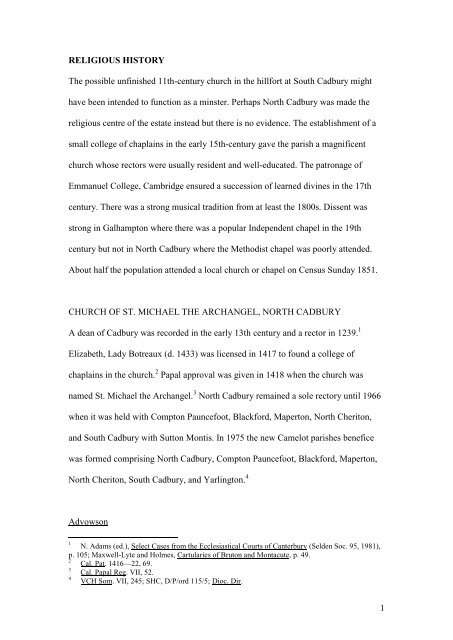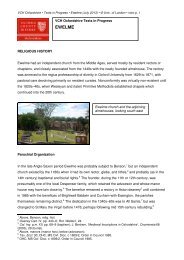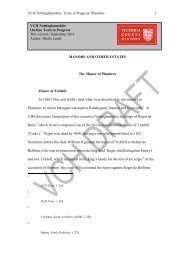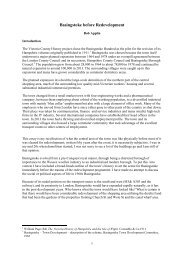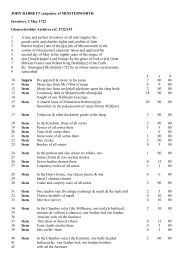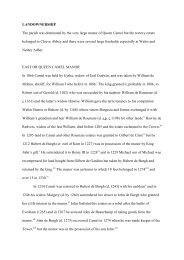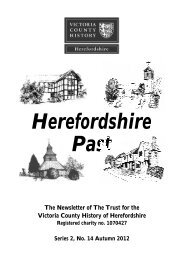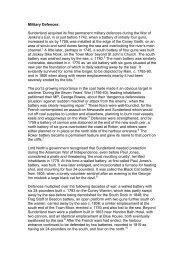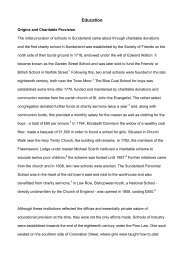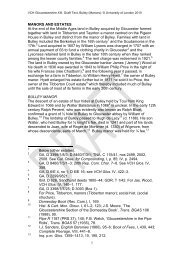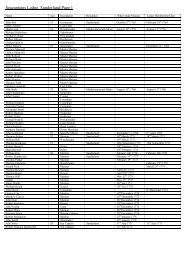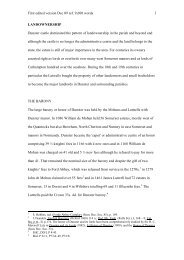North Cadbury Religious History - Victoria County History
North Cadbury Religious History - Victoria County History
North Cadbury Religious History - Victoria County History
Create successful ePaper yourself
Turn your PDF publications into a flip-book with our unique Google optimized e-Paper software.
RELIGIOUS HISTORYThe possible unfinished 11th-century church in the hillfort at South <strong>Cadbury</strong> mighthave been intended to function as a minster. Perhaps <strong>North</strong> <strong>Cadbury</strong> was made thereligious centre of the estate instead but there is no evidence. The establishment of asmall college of chaplains in the early 15th-century gave the parish a magnificentchurch whose rectors were usually resident and well-educated. The patronage ofEmmanuel College, Cambridge ensured a succession of learned divines in the 17thcentury. There was a strong musical tradition from at least the 1800s. Dissent wasstrong in Galhampton where there was a popular Independent chapel in the 19thcentury but not in <strong>North</strong> <strong>Cadbury</strong> where the Methodist chapel was poorly attended.About half the population attended a local church or chapel on Census Sunday 1851.CHURCH OF ST. MICHAEL THE ARCHANGEL, NORTH CADBURYA dean of <strong>Cadbury</strong> was recorded in the early 13th century and a rector in 1239. 1Elizabeth, Lady Botreaux (d. 1433) was licensed in 1417 to found a college ofchaplains in the church. 2 Papal approval was given in 1418 when the church wasnamed St. Michael the Archangel. 3 <strong>North</strong> <strong>Cadbury</strong> remained a sole rectory until 1966when it was held with Compton Pauncefoot, Blackford, Maperton, <strong>North</strong> Cheriton,and South <strong>Cadbury</strong> with Sutton Montis. In 1975 the new Camelot parishes beneficewas formed comprising <strong>North</strong> <strong>Cadbury</strong>, Compton Pauncefoot, Blackford, Maperton,<strong>North</strong> Cheriton, South <strong>Cadbury</strong>, and Yarlington. 4Advowson1N. Adams (ed.), Select Cases from the Ecclesiastical Courts of Canterbury (Selden Soc. 95, 1981),p. 105; Maxwell-Lyte and Holmes, Cartularies of Bruton and Montacute, p. 49.2Cal. Pat. 1416—22, 69.3Cal. Papal Reg. VII, 52.4VCH Som. VII, 245; SHC, D/P/ord 115/5; Dioc. Dir.1
The advowson belonged to <strong>North</strong> <strong>Cadbury</strong> manor and although in 1427 the collegewas to elect a rector 5 in 1456 it was said that no ‘canonical’ presentation had beenmade. 6 The advowson remained with the manor 7 until the 1620s when it was claimedby Emmanuel College, Cambridge under a grant of 1586. In 1622 both EmmanuelCollege and Matthew Ewens presented and in 1623 the college’s presentee held theliving pending a hearing, which the college won. Emmanuel held the advowson until1975 when it passed to the patronage board of the team ministry. 8Income and PropertyIn 1291 the church was valued at £13 6s. 8d. 9 The college of chaplains was to beendowed with 2 a. for their house, two houses, 32 a., rent, and pasture and in 1418 thepope allowed revenues to be apportioned between the clergy. The college was notfounded until after 1423 when it was allowed to acquire lands to the value of £66 13s.4d. 10 In 1427 the bishop approved the scheme and in 1428 John Camel of Woolstongave his manor of Lattiford, returned to him in 1438, and 17 a. in Queen Camel to thecollege. 11 The church was assessed at 20d. in 1445, presumably because most assetshad been transferred to the college, but the retiring rector in 1452 received £10 ayear. 12 In 1535 the church was worth £29 9s. 6d. gross, c. £300 by 1661 and £809 by1835. 135T. S. Holmes (ed.), Register of Bishop Stafford, 1425—1443 (Som. Rec. Soc. 31, 1915), p. 73.6H. C. Maxwell-Lyte (ed.), Register of Bishop Bekynton, 1443—65 (Som. Rec. Soc. 49, 1934), pp.191, 266—7.7H. C. Maxwell-Lyte (ed.), Registers of Bishop Stillington 1466—91, and Bishop Fox, 1492—4(Som. Rec. Soc. 52, 1937), pp. 163—4; F. W. Weaver (ed.), Som. Incumbents (1889), 40; above,landownership; SHC, D/D/Bp 5.8SHC, D/D/Bp 5, 276; TNA, C 3/342/8; Weaver, Som. Incumbents, 40; Report of the RoyalCommission on Ecclesiastical Revenues (Parl. Papers 1835 (67) xxii), pp. 130—1; Dioc. Dir.9Tax. Eccl. 197.10111213Cal. Pat. 1416—22, 69; 1422—9, 189—90; Cal. Papal Regs. VII, 52.Holmes, Register of Bishop Stafford, pp. 72—3; SDNQ. II, 127.Maxwell-Lyte, Register of Bishop Bekynton, pp. 31, 191.Valor Eccl. I, 153; SRO, D/D/Vc 24; Rep. Com. Eccl. Revenues (1835), pp. 130—1.2
In the 1540s the rector claimed that some glebe was withheld. It was claimedby the heirs of the four granddaughters of Thomas Clare who gave lands inKilmersdon and <strong>North</strong> <strong>Cadbury</strong> to pay the salary of a priest presumably as part of thecollege foundation. 14 The lands were confiscated as chantry land, were claimed by theearl of Huntingdon as lord of the manor, 15 but were restored to the church before 1571when the glebe comprised 148 a. and tenements in <strong>North</strong> <strong>Cadbury</strong> (c. 12 a.),Kilmersdon (c. 35 a.), and Coleford. 16 A close was given to the rector in the later 16thcentury in lieu of tithes of stock meadows when those were enclosed and in 1837 theglebe was more accurately measured at 144 a. 17 Despite exchanges in 1880 18 the landwas scattered and without farm buildings making it difficult to let. Some was used toprovide allotments for each village. The Revd. William Castlehow (d. 1896) gave twohouses to the rectory but his successor sold them with part of the glebe in 1921 toraise £6,500 for a pension. Some land remained unsold in 1959. 19Tithes were worth £22 5s. in 1535, 20 by the 1780s the tithes were paid by an‘easy’ modus 21 and in 1837 were commuted for a rent charge of £489 12s. 2 1/2d. 22After 1417 2 a. adjoining the churchyard was enclosed for a dwelling foreleven college clergy, possibly to incorporate a chapter house. 23 In 1626 theparsonage house site included the college house 24 but it was not recorded again. In the1780s the rectory house was ‘pretty’ with plantations, 25 but decayed for lack of repair14TNA, C 1/1087/3—7; C 1/1319/35; E. Green (ed.), Somerset Chantries, 1548 (Som. Rec. Soc. 2,1888), 129.15Green, Som. Chantries, 129—30, 306; Cal. Pat. 1554—5, 1715.16SHC, D/D/Rg 125.17Court books in private hands; SHC D/P/cad 3/1/1; ibid. tithe award.18SHC, DD/FF 19/1.19Ibid. D/P/cad. n 3/1/2—4.20Valor Eccl. I, 153.21SHC, A/AQP 9.22Ibid. D/P/cad. n 3/1/1.23Cal. Pat. 1416—22, 69; Holmes, Register of Bishop Stafford, 49.24SHC, D/D/Ca 236, 255; ibid. D/D/Rg 125.25Ibid. A/AQP 9.3
and was demolished in 1813. A large new house was completed in 1815 by ThomasEllis of Sherborne at a cost of nearly £2,800. Some doorcases and chimneypieceswere re-used and the new house was provided with decorative plasterwork by RobertTaylor, a Doric portico, marble and Pibsbury stone fireplaces, Keinton stone pavingand some fitted furniture. 26 In 1861 a large carriage house with stables was added. In1975 the barn and coach house were sold for conversion to dwellings, a new clergyhouse was provided, and the Old Rectory became a private house. 27Pastoral Care and Parish Life to 1600Richard of Brankescombe had licence to study in 1331—2 provided he resided fortwo weeks in Lent and at the bishop’s visitation but he exchanged his living in 1333.He was only a deacon when presented again in 1348 and held Cornish churches and aprebend in Salisbury diocese. 28 Richard Graneby, instituted 1349, was licensed in1361 to hold a canonry of Exeter 29 and in 1377 there were three assistant clergy. 30John Ferour (d. c.1407) at his own expense rebuilt the church tower where his tomblay until 1567 when it was destroyed by the fall of the great bell. 31 In 1408 HenryNansumer had licence to be absent in Lady Botreaux’s service 32 and presumably thedemolition and rebuilding of the church was about to begin.Richard Wyche, instituted in 1420, 33 became the first college rector,renouncing his rights in the parish church, but retaining sole care of souls. It isunlikely that the college ever had the intended seven priests and four clerks but two26Ibid. D/D/Bbm 35; D/D/Rb 1815.27Ibid. D/P/cad. n 3/4/1—2; D/D/ord 115/5; Dioc. Dir.28T. S. Holmes (ed.), Register of Bishop Ralph of Shrewsbury, 1327—63 (Som. Rec. Soc. 9—10),pp. 91, 99, 140, 585; Emden, Biog. Reg. Univ. Oxon.29Holmes, Register of Bishop Ralph of Shrewsbury, p. 614; Cal. Papal Pets. I, 363.30Castle Cary Visitor, May 1907.31Cal. Papal Regs. V, 128, 145; T. S. Holmes (ed.), Registers of Bishop Gifford 1265—1266 andBishop Bowett, 1401—1407 (Som. Rec. Soc. 13, 1899), 72; SHC, D/P/cad. n 2/1/1.32Holmes, Register of Bishop Bubwith, p. 36.33Ibid. p. 30.4
chaplains were received into the college in 1427. It is not clear what effect if any thefounding of the college had on the parish. Its clergy were to pray for the good of theking, Elizabeth, Lady Botreaux, her husband, and her grandson William but in 1435William was allowed to move the bodies of two of his children to Bridgwater friary. 34The early 15th-century monument to Lord and Lady Botreaux 35 under the tower wasremoved from beside the altar after 1846. 36The two chaplains recorded in 1450 were an anniversary chaplain and therector’s namesake ordained acolyte in 1448 but a subdeacon ordained in 1451possibly belonged to the college. Wyche retired in 1452 but his successor was notrecognised and a new rector was instituted in 1456. 37 The church was described in1490 as a rectory or college with two chaplains in 1494. 38 Fourteen chancel stalls withcanopies and misericords, probably for the college priests, were removed in the 19thcentury. 39 The medieval glass fragments in the west window were removed there from<strong>Cadbury</strong> House in 1891 in the belief that they had been taken from the church at thereformation. Fragments of the contemporary stone pulpit were said to survive in therectory garden in 1890. 40 A medieval altar slab, removed before 1633, 41 hangs on thesouth chancel wall.34Holmes, Register of Bishop Stafford, pp. 31, 170.35Bates (ed.), Gerard’s Survey, 190. Presumably the church builder Elizabeth Daubeney (d. 1433)although this has been doubted because of the effigy’s youthful appearance whereas Elizabeth diedaged over 80.36Wheatley sketch 1846: M. McGarvie (ed.), Sir Stephen Glynne’s Church Notes for Somerset(Som. Rec. Soc. 82, 1994), 65.37Maxwell-Lyte, Register of Bishop Bekynton, pp. 136, 191, 266—7, 485, 491.38SHC, T/PH/htn 1; Weaver, Somerset Wills, 319—20.39SHC, A/AQP 9; Excursion to N <strong>Cadbury</strong> church, PSAS. 59 (1914), 43. Some misericords latergiven to the Royal Albert Museum, Exeter.40Kelly’s Dir. Som. (1910); excursion to N <strong>Cadbury</strong> church, PSAS. 36 (1891), 57.41Bates, Gerard’s Survey, 190.5
James FitzJames, rector 1521—41, was a multiple pluralist and Chancellor ofWells but had a curate c.1530 and the church was reseated at this period. 42 NicholasWalker, rector 1541—65, had difficulties with the college estate and c.1546 with hiscurate, William Walys, who contracted to serve a year for £5 but left early. 43 Theregisters date from 1558. 44 The church was last described as collegiate in 1548 whentwo chaplains each received a pension, another had already vacated, and there was anobit for William Botreaux. 45Money and 6 a. were given to maintain lights between 1496 and 1548. 46 In1555 a bushel of wheat was given to the Whitsunday church ale 47 but Sir FrancisHastings (d. 1610) left £20 to the church provided there were no more church ales,which he described as profaning the Sabbath, causing drunkenness and riot, andcorrupting youth. 48 One of two chest tombs placed end to end under the tower,probably moved from the chancel in the 1860s, is reputedly of Sir Francis Hastingsand his first wife Magdalen (d. 1596), commemorated in a long poem on the wallabove. The other, dated 1611, is possibly of Frances Rogers, wife of Mathew Ewens(d. 1598). 49Pastoral Care and Parish Life after 160042H. C. Maxwell-Lyte (ed.), Bishops’ Registers, 1518—1559 (Som. Rec. Soc. 55, 1940), pp. 15, 90;Emden, Biog. Reg. Univ. Oxon.; SHC, D/D/Vc 20.43Maxwell-Lyte, Bishops’ Registers, 90; SHC, D/D/Bp 5; TNA, C 1/1087/3-7; C 1/1319/35; C1/1320/13—15; Shilton and Holworthy, Medieval Wills, 157.44SHC, D/P/cad. n 2/1/1.45Green, Somerset Chantries, 130.46Weaver, Somerset Wills, 319; Green, Somerset Chantries, 130. Probably the land let by the Crownin 1572 with 2 a. in Galhampton given to Yarlington church: Cal. Pat. 1569—72, p. 389.47Shilton and Holworthy, Medieval Wills, 231.48Cross, Letters of Sir Francis Hastings, 117—18.49Above, landownership. In the 1780s there were also in the chancel the carved arms of Ewensimpaling Hales for Mathew Ewens (d. 1628) and Katherine Hales (d. 1612); SHC, A/AQP 9.6
Rectors were normally resident 50 although there was an unordained curate in 1623. 51The church plate comprises a cup and cover of 1631 by ‘B.F.’ In 1685 thechurchwardens paid to have it hidden. 52 Rector John Dodd, prebendary of Wells,disappeared in 1643, supposed to have died in prison for debt. A new rector wasappointed but Dodd was discovered living under an assumed name in the 1650s. 53Baldwin Acland, presented in Dodd’s place, had his episcopal institution declaredvoid and the House of Lords ordered the institution of the Cambridge ‘Platonist’Benjamin Whichcote, Provost of King’s but Acland served as curate in 1649 when hehad as pupil George Bull, later a theologian and bishop of St. David’s. 54 In 1649Whichcote, who with a parishioner had attended a Presbyterian classis in 1648, 55 wassucceeded by Cambridge scholar Ralph Cudworth. 56 In 1656 Cudworth was followedby the puritan Samuel Craddock, author of theological works, including Knowledgeand Practice (1659) written for his parishioners. He was ejected in 1662 and later keptan academy in Suffolk. 57 William Peirs, rector 1712—50, was a prebendary of Wellsand grandson of Bishop Peirs. 58Resident curates were employed even by resident rectors and there were fourcelebrations of communion from the 17th century to the early 19th when two services50SHC, D/P/cad. n 2/1/1—2; SDNQ. XIV, 265.51SHC, D/D/Ca 236.52E. H. Bates, ‘An Inventory of Church Plate in South-East Somerset’, PSAS. 43 (1897), 184; SHC,D/P/cad. n 4/1/1, 5/2/1.53Cal. SP Dom. 1637—8, 362; 1638—9, 61; J. M. Horn & D. S. Bailey (ed.), Fasti EcclesiaeAnglicanae 1541—1857, V Bath and Wells (1979), 24, 29; Lambeth Palace Lib. MS. COMM.A/1/28;TNA, E 134/1654/East 3.54TNA, E 134/1654/East 3; Lambeth Pal. Lib. MS. COMM.I/82—3; HL. Jnl. VIII, 30a; DNB; A. G.Mathews (ed.), Walker Revised, 308.55W. A. Shaw, A history of the English church: during the civil wars and under the commonwealth1640-1660 (1900), II, 416.56TNA, E 134/1654/East 3; A. E. Robinson (ed.), Life of Bishop Kidder (Som. Rec. Soc. 37, 1922),189.57DNB; Robinson, Life of Bishop Kidder, 189; J. S. Cockburn (ed.), Somerset Assize Orders,1640—1659 (Som. Rec. Soc. 71, 1971), 62.58SHC, D/P/cad. n 2/1/1; Fasti, Bath and Wells, 1541—1857, 54.7
were held each Sunday. 59 The church acquired a second cup and cover, with almsdish,of 1742 by Thomas Mann. 60 In 1769—70 the five bells were recast into six by theBilbie family. The tenor was recast at Bridgwater by John Kingston in 1818. 61In the1780s the ‘large and stately edifice’ was in good condition the pillars, arches andwalls having recently been painted white. The chancel was wainscoted and there wasa railed communion table. There were private pews and a singers' gallery in the nave,repaired in 1727, with painted landscapes of church, manor house, rectory, and<strong>Cadbury</strong> Castle, probably carried out in 1777. 62 Lead was stolen from the roof c.1806and in 1843 the windows and chancel were repaired following minor work on thetower. 63 Samuel Blackall, rector 1812—42 and prebendary of Wells, was a founder ofthe East Somerset Savings Bank and acquainted with Jane Austen. 64 In 1851 averageattendance was 70 in the morning and 160 in the afternoon. 65 William Castlehow,rector 1861—96, former fellow of Emmanuel College, Cambridge and a Hebrewlecturer, paid for much of the church restoration in the 1860s and celebrated monthlycommunion. 66 Herbert Boys, rector 1897—1927, was a fellow of the RoyalMeteorological Society and founded a society to study rainfall. 67In 1808—9 a man called the chorister was paid to teach young singers. Theparish had a late 18th or early 19th-century Cahusac hautbois presumably used at thatperiod but acquired an organ, probably in 1866 when the gallery was removed. 68 In59SHC, D/P/cad. n 2/1/2, 4/1/1; D/D/Bo; D/D/Rb 1815, 1827; D/D/Va 1/4, 2/4.60Bates, ‘Inventory of Church Plate in S-E Som’, PSAS. 43, 184; SHC, D/P/cad. n 5/2/1.61SHC, DD/SAS CH 16; D/P/cad. n 4/1/1—2.62Ibid. A/AQP 9; ibid. D/P/cad. n 4/1/2.63Ibid. D/P/cad. n 4/1/3; D/D/Va 1843.64Fasti, Bath and Wells, 1541—1857, 29; Miller, Parson’s Quarter to Purgatory 157.65TNA, HO 129/320/1/7.66Castle Cary Visitor June 1896; SHC, D/D/Va 12/4, 14/4.67Miller, Parson’s Quarter to Purgatory, 44.68SHC, D/P/cd. n 4/1/3; D/D/Rrd 6; McGarvie, Sir Stephen Glynne’s Church Notes, 65; Miller,Parson’s Quarter Companion, 125.8
1902 the parish paid an organist and an organ blower and c.1905 the organ wasrebuilt. 69 In 1906 a surpliced choir was introduced to which women were admitted in1947. 70 The churchyard was extended c.1900, a lychgate was added c.1910, and on aboundary wall, formed by an outbuilding of <strong>Cadbury</strong> Court, was placed a group ofbronze resin figures representing the Redemption by John Robinson of Galhampton. 71A clock purchased in 1672 was replaced in 1901 by a dial clock from Smith of Derbyand the bells, two recast in 1929, were rehung in 1981. After 1903 work was carriedout under C. E. Ponting to the roof and clerestory windows, underfloor heating wasinstalled, north and south doors were replaced, and the tower partly rebuilt includingthe pinnacles and battlements, cramped in 1689. Canon Newbolt of St Paul’s preachedto celebrate completion of the work in 1906. 72 The roof was again rebuilt in 1933—4when corbels by Uria Lintern dated 1862 were found. Problems with beetle and dampaffecting the roof, floors, and the porches with their upper rooms where the churchrecords were then kept, led to further restoration in 1971. A Friends of St Michael’scharity was established in 1994 to maintain the fabric and bronzes of the evangelistsby Lyn Constable-Maxwell were placed in the reredos. 73St Michael the Archangel 's churchThe church appears to have been completely rebuilt; the tower by the rector JohnFerour (d. 1408) 74 and the rest by Elizabeth, Lady Botreaux (d. 1433) before 1417. 7569SHC, D/P/cad. n 4/1/4.70Miller, Parson’s Quarter to Purgatory, 150.71Ibid. 147; SHC, D/P/cad. n 4/1/4, 5/3/1; DD/X/MKN 9.72SHC, D/P/cad. n 4/1/1—2, 4; D/D/Cf 1905/132; DD/SAS CH 16; Miller, Parson’s Quarter toPurgatory, 148.73SHC, D/P/cad. n 8/3/1; D/D/Rrd 3, 6; DD/WBF 20/336/1; Char. Com. Reg.74SHC, D/P/cad. n 2/1/1; Holmes, Register of Bishop Bubwith, p. 36.75Cal. Pat. 1416—22, 69. A 1417 datestone was said to have been found in the 1860s with a chiselon top of wallplate in the chancel.9
A major restoration in the 1860s, possibly by John Norton, included rebuilding theroof for which the parish borrowed £300 and work on the chancel paid for by therector including a new altar, reredos with Painswick stone figures, stalls, a tiled floor,roof, and sedilia and probably the removal of the tombs to the tower. 76 In the 20thcentury much of the roof was rebuilt and pinnacles replaced by battlements.The outstanding church fittings are the bench ends of the 1530s, which includesaints, several sets of faces and initials, presumably of parishioners including theHastings Knot and RS possibly for Richard Sacheverell, second husband of LadyHastings in 1530, heraldic symbols including the FitzJames dolphin and the so-calledarms of Joseph of Arimathea, a flute player, a packhorse, a windmill, a church, aheron, snails, and a cat with mousetrap.CHURCH OF ST. GABRIEL, GALHAMPTONGalhampton church, later dedicated to St Gabriel, was built in 1887 77 as a missionroom at the east end of the village and given to the rector in 1912 for the religiouswelfare of Galhampton’s inhabitants. By 1906 there was a choir and in 1912—13more services and communion were requested but the rector was reluctant and wouldnot appoint a curate saying it should never become a consecrated church or have asanctuary. 78 However, by 1948 communion was celebrated at Galhampton, which hadcommunion plate and altar rails given by Castle Cary church. A bell was provided in1935. Services were last held in 1970 and it was decided to use the former76SHC, D/P/cad. n 4/1/3—4; Excursion to <strong>Cadbury</strong> Camp, PSAS. 16 (1871), 17—18; McGarvie, SirStephen Glynne’s Church Notes, 65.77Datestone; SHC, D/D/Rd 6.78SHC, D/P/cad. n 4/1/4, 8/1/1, 9/1/1.10
Congregational chapel, where a weekly Sunday service was held in 2002. St Gabriel’swas sold in 1973 to become a private house. 79NONCONFORMITYBy the 1660s there were many dissenters, possibly followers of Samuel Craddock. 80 AQuaker was imprisoned in 1659 for not paying tithes 81 and in 1670 six people from<strong>North</strong> <strong>Cadbury</strong> and Woolston attended a Quaker meeting at South <strong>Cadbury</strong> includinga woman buried as a Quaker in 1699. 82 By that date Presbyterians and Independentswere meeting in the parish and houses were licensed for unspecified congregations at<strong>North</strong> <strong>Cadbury</strong> in 1717, 1824 and 1833, at Galhampton in 1689 and 1837, atBrookhampton in 1843, and at Three Ashes in 1846. 83PresbyteriansIn 1669 two Dorset ministers preached in the parish, one for 20 years. JeromeLittlejohn (d. 1680), an ejected minister, licensed his house for Presbyterian use in1672. 84 In 1718 his son Joseph Littlejohn was said to have 250 at his meeting. 85 Hishouse was licensed in 1720. In 1742 a house at Galhampton was licensed forPresbyterian worship. 86Independents79Ibid. 5/2/1; D/D/Rd 6; D/P/holt 23/5.80Ibid. D/D/WLS, box 2.81J. Besse, Sufferings of the Quakers (1753), I, 585.82S. C. Morland (ed.), The Somersetshire Quarterly Meeting of the Society of Friends 1668—1699(Som. Rec. Soc. 75, 1978), 6, 73, 78, 97, 124; SHC, Q/SI 126/1; ibid. D/P/cad 2/1/1.83SHC, Q/RRw 1; ibid. D/D/Rm 6, 8—10.84A. G. Matthews, Calamy Revised, 32; SANHS. Lib. Taunton, T. G. Crippen, The Story ofNonconformity in Somerset, (1913—1914), 28; G. L. Turner (ed.), Original Records of EarlyNonconformity under Persecution and Indulgence (1911), II, 1089; Cal. SP Dom. 1672, 400.85Crippen, Nonconf. in Som. 39.86SHC, Q/RRw 1.11
The Galhampton Congregational meeting, held in 1709 in the house of John Taunton,was variously said to have been started by Samuel Craddock or the Littlejohns butapparently ceased by 1727. However Thomas Cozens built and endowed anIndependent meeting house before 1761 when his son, also Thomas, conveyed the siteto trustees. 87 It had no minister in 1773 but three bequests totalling £100 were investedin land charged with £5 a year to support a minister in 1793. 88 The meeting house waslicensed in 1804, possibly after rebuilding, 89 and shared a minister with Castle Caryexcept between 1837 and 1871. 90 In 1845 a group seceded from Galhampton chapeland held services at a little chapel called Salem, which closed at Christmas 1850 butre-opened the following year. It was abandoned in 1852 but the tiny congregationcontinued meeting in a private house. 91In 1851 attendance was 60 in the morning and 90 in the afternoon. 92 JosephFrancis of the former Golden Lion, Castle Cary, and his wife, sister of the minister,left £300 c.1868 to pay for rebuilding. 93 In 1876 the chapel, on the road to CastleCary, was demolished and a new chapel and schoolroom were built by E. O. Francisin the centre of Galhampton. 94 In 1962 a monthly afternoon service was attended by38 adults and children. The church was closed in 1963 although services continued87D. J. Gass, The Days that Were: a short historical sketch of Zion Chapel, Castle Cary, Somerset,(1943) 6; Annual Report of the Somerset (1896) Congregational Union and of the Evangelist Societypresented at the One-Hundredth Anniversary (1896)l SHC, DD/FS 25/5/19; Castle Cary Visitor March1897.88Crippen, Nonconf. in Som. 43; SHC, D/N/scu 3/4/6; Castle Cary Visitor March, April 1897;Suppl. to Return of Endowed Chars. (1891), 12—13.89SHC, D/D/Rm 3.90Rep. Som. Cong. Union (1896).91Hants RO 30M73/F2—5. The site is unknown, if Salem was Mr Cock’s Grove chapel, recorded atthe same period, it may have been at Grove farm, Pitcombe.92TNA, HO 129/320/1/14.93Inf. from Dr. J. Jurica, Editor, VCH Gloucs.94Suppl. to Return of Endowed Chars. (1891), 12—13; Rep. Som. Cong. Union (1896); Castle CaryVisitor May 1897.12


